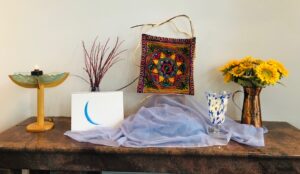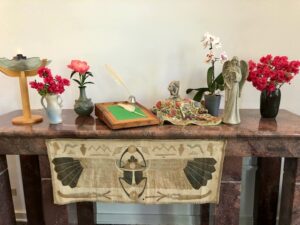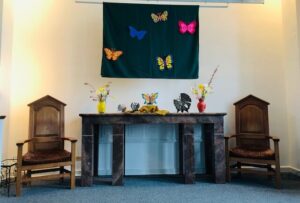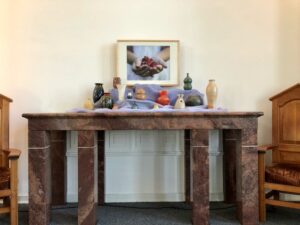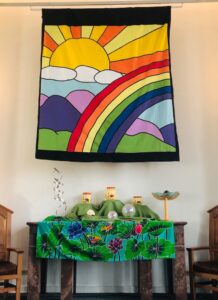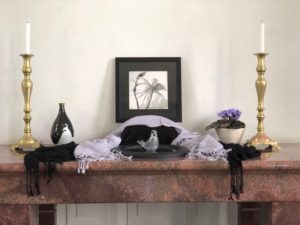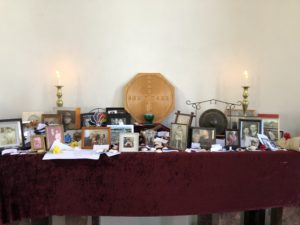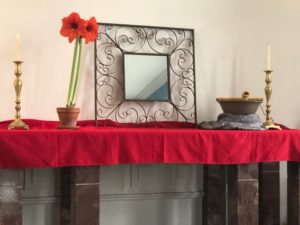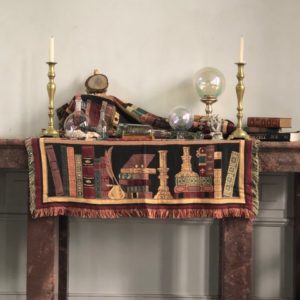OPENING: Time
Time and tides wait for no one.
Time and tides wait for no one.
A theology professor once stood in front of a class and said: “Time and tides wait for no one, so I hope you’ve picked your title and research articles for the term paper that is due in three weeks.”
This is a truth….we can not hold back time. The changes of life will come.
The earth turns,
the seasons change,
and we have these things called clocks that help us mark the time.
….and we even have this funny thing called daylight savings.
The calendar and the clock show a steady tick of the minutes, days, weeks, years.
This is unlike spiritual time, which happens in mysterious leaps and bounds, mysterious gaps and rushes.
In spiritual time, you may feel endless despair followed by a rush of joy, neither of which logically could fit into the measure of a clock or calendar.
In spiritual time, grief has its ebbs and flows that defy prediction.
In spiritual time, a wounded heart heals after years and becomes ready to make repair with another person.
We humans live in this paradox of dwelling in both calendar time and spiritual time.
It is as if: we have one foot on a steadily moving conveyer belt
and the other foot in the stirrup of an unpredictable horse.
Today, I am inviting us to focus on the clock and calendar time: the steadily moving conveyor belt: the concrete things that our values call us to do.
Building relationships, and communities of justice requires concrete actions that happen in calendar time.
They require many small steps that are part of a long march.
They require planting many row of seeds so there will be a harvest later.
Sometimes, they require many meetings to build a consensus.
STORY OF TEAM BUILDING AND READINESS FOR ACTION
Let me paint a picture of a scene for you. I was 22 years old, on a Tuesday evening after working at my job in an office north of Seattle, having ridden for 30 minutes on two different buses to get to my neighborhood south of the city, and walked to a community center two blocks from my house. The name: El Centro de la Raza: The Center for People of All Races.
They had community nights every Tuesday and Thursday. The community nights were work parties: sometimes doing mailings about events, sometimes helping the kids with homework, sometimes cleaning closets, doing whatever it seemed needed to be done.
On this particular Tuesday night, a large room is abuzz with activity, and I am sitting at a table with two other people. I have just now met them about five minutes before. One is named Jose, and the other Guillermo. In front of us on the table are about a thousand envelopes. All of them have labels—that was done at the work party last week. Our task now is to put them in order by zip code. Then, they need to be bundled by region, and put in mailing trays according to post office standards. The mailing instructions are in English. I speak English but not much Spanish. Jose and Guillermo speak Spanish but not much English. How can I communicate the instructions to them?
Do I mime?
Do I point a lot?
Do I say Yes, yes, no, no?
I cannot recall exactly how we proceeded, but I recall awkwardness, and laughter.
This was not a very efficient way to sort and prepare a bulk mailing.
At the end of the two hour work party, I apologized to the coordinator and said that we had only finished half, that we were slowed down because of trying to figure out how to communicate and work together.
“Wonderful!” he boomed! “That is exactly why we are here. To figure out how to communicate even across language lines, even across cultural differences.”
The point was ultimately, not most importantly to get the mailing done, or to get the closet clean. The point was to work together with other people who are our neighbors that we might not actually know. The point, one of the leaders told me, was to practice working together. The point was that when the time came, because such times do tend to come, that our neighbors’ very lives were threatened, or own lives were threatened, that we already had an infrastructure for working together. Then, if we needed to mobilize against unjust policies, we already knew how to quickly come together. Leadership structures were constantly being practiced.
There were other benefits: Over the next few weeks, when I saw Jose in the neighborhood grocery store, he said hello and introduced me to his daughter. One night when I as waiting at the bus stop in the dark alone and a man approached, it was Guillermo and we greeted each other warmly.
A POEM ABOUT OUR INTERCONNECTEDNESS
Let me offer you a centuries old poem that is attributed to a Chinese woman, although no name is given. Her poem says:
I take a lump of clay
And make a figurine of you
I take another lump of clay
And make a figurine of me.
I crush them together.
And out of that lump of clay
I again make a figurine of you
And a figurine of me.
Now, there is You in Me
And there is I in You.
Here is the point: we are interconnected, and we need to always keep building relationships for the common good, and this takes concrete actions.
SITUATIONS FOR CONCRETE ACTION
There are lots of situations where we need to be ready to show up and work together. One example is our partnership with the Unitarians in the region of Romania called Transylvania. This month, one of our members will be visiting there. Children in our religious education have made cards to send them. These are just simple drawings, but they contribute to sustaining a connection over time.
A second example of being ready to show up and work together is that I got an email on Friday from the national professional association of my colleagues called the Unitarian Universalist Ministers Association. That staff has assembled examples of how other congregations in areas affected by the coronavirus have been handling it, so that we here can benefit and learn from their examples.
A third example is the organization called IMPACT.
IMPACT stand for Interfaith Movement Promoting Action by Congregations Together. It encompasses faith groups throughout Charlottesville and Albemarle County.
This year IMPACT discussion groups met, listened, discussed, researched, and picked two problems that can be improved.
One problem identified is affordable housing. There are 6,600 families who are one paycheck away from homelessness in the city and county. Rents have increased by 42% between 2011 and 2018. IMPACT is asking for a new zoning map in the city so that affordable housing can happen in every neighborhood. In the County, IMPACT is asking for a trust fund that will prioritize low-income seniors.
The second problem IMPACT has chosen to work on this year is Immigrant Conditions. The jail helps ICE capture up to 50 people per year upon their jail release and the majority are non-violent offenders. There is no law requiring this, and IMPACT is asking the jail board to stop voluntary notifications to ICE for those convicted of non-violent crimes. Community safety is impacted when the immigrant community does not trust the police to help them in times of need.
These concrete requests for action are a way of stewarding the good of this local community. It is similar to concrete actions that we take in the stewardship of this congregation.
CULTURAL HUMILITY
IMPACT’s way of doing things is carefully thought out. They are practicing cultural humility with each other. They approach each other and each situation with curiosity and humility. They begin with listening to each other, to neighbors, to people of other faiths. From that stance of humility, they build an action plan with clear requests to elected officials, and then bring the power of numbers of people.
CLOSING
My message in this sermon is steadiness.
Know your values.
Show up.
Get accurate information.
Proceed with steady energy toward a concrete outcome for a shared good.
Time and tides wait for no one.
I will close with a verse. I’m not exactly certain of the source, but I was told it was translated from the Sanskrit language from thousands of years ago in the region we now call India. The verse says:
Yesterday is but a dream, tomorrow is but a vision
But today well lived make every yesterday a dream of happiness,
And every tomorrow a vision of hope.
Look well, therefore, to this day.
Blessed be,
Amen

